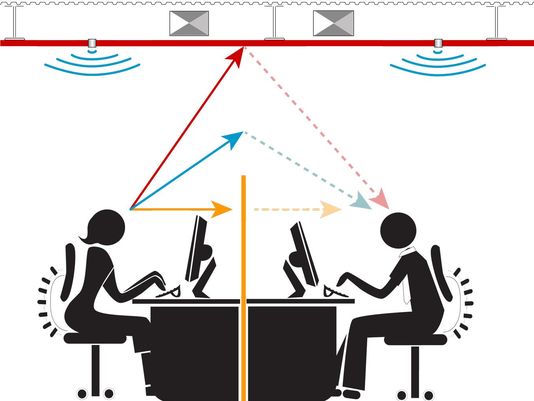Sound masking in depth – achieving acoustic comfort and speech privacy
Sound masking is the addition of natural or artificial sound (sometimes less-accurately known as ‘white noise’ or ‘pink noise’) into an environment to ‘mask’ or cover up unwanted sound by using auditory masking.

The use of sound masking techniques can help to reduce or eliminate awareness of pre-existing sounds in a given area, to bring benefits such as acoustic comfort and speech privacy to the workspace.
Sound masking can be explained by analogy with light. Imagine a dark room where someone is turning a torch on and off. The light is very obvious and distracting. Now imagine that the room lights are turned on. The torch is still being turned on and off, but is no longer as noticeable because it has been ‘masked’. Sound masking is a similar process of covering a distracting sound with a more soothing or less intrusive sound.
Why use sound masking?
Results from studies point to noise in the workplace environment as a major cause of reduced effectiveness, higher stress and declining job satisfaction.
The modern, often open-plan office environment is particularly vulnerable to factors which contribute to the level of unwanted noise in the workspace, namely:
- Increased workstation densities and decreased workstation sizes for all types of workers, which mean more employees are working in closer proximity to each other than ever before, reducing speech privacy.
- Creation of office ‘teaming’ areas that increase noise levels as a result of the interactive conversations required in this type of environment.
- More widespread use of speakerphones and the tendency of employees to speak more loudly when using them.
An effective sound masking system can help reduce these sources of stress and distraction and bring benefits such as improved concentration and productivity the workspace.
In addition, speech privacy is quickly becoming a concern in a variety of environments ranging from healthcare facilities, where doctor-patient confidentiality is critical, to banks, building societies and post offices where speech privacy is vital in preserving confidentiality and combatting fraud.
Where can sound masking be used?
Sound conditioning can be used in any environment where there is a need for increased acoustical comfort and/or speech privacy and the background sound level is low. Sound masking is typically used in selected workspaces and public areas. The most common sound masking installations are:
Open Plan Offices
Open offices can be too quiet, making the conversations of others in the office distracting. Open offices can benefit from sound masking because the added sound covers existing sounds in the area – making workers less distracted, more productive and improving speech privacy.
Public Spaces
Sound masking as a speech privacy system is useful for reception areas, pharmacies, waiting rooms and financial institutions. The system is provided in the area where conversations should not be heard – not necessarily in the area where the conversation is taking place. For instance, a solicitor does not want those in the waiting room to overhear private conversations with a client so sound masking is provided in the waiting area to provide clients with speech privacy.
Private Offices
Private offices and other enclosed spaces often appear to provide speech privacy but actually do not. Walls are often lightweight and do not extend to the ceiling deck – only to the ceiling tile. In these cases, sound can easily travel through partitions or over the walls. Sound conditioning can be provided in adjacent private offices, or in hallways outside of private offices, to ensure that confidential conversations remain confidential.
What does sound masking sound like?
Nothing: correctly installed, the resulting ambient noise is not normally noticed by occupants. When heard in a silent environment, the sound can be compared to a gentle sound like air flowing through a vent.
